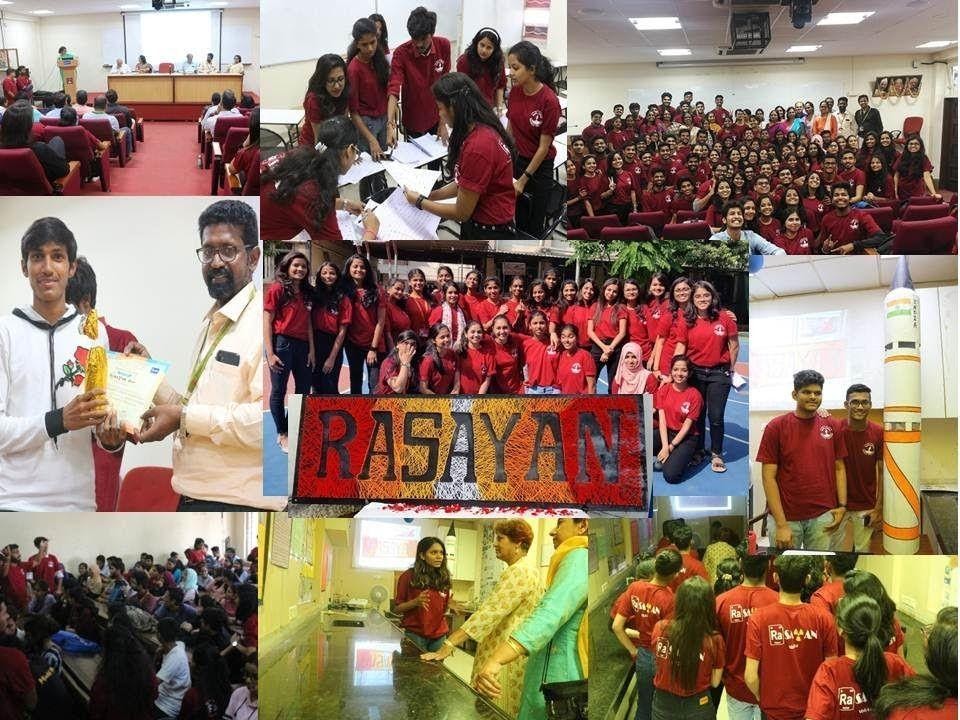The M.Sc. program is a four semester Autonomous Program. The highlight of the program is full time project work/ internship which a student has to complete in fourth semester to inculcate Research and Innovation Aptitude. This ensures that the student is well equipped for future research in academics or for research and development in industries/research organizations.
The curriculum enables the students to apply the principles of stereochemistry, reaction mechanism and advanced spectroscopic techniques in the synthesis of organic compounds. Name reactions with mechanism (involvement of reactive intermediates), retrosynthetic approach towards organic synthesis and reactivity of simple organometallic compounds, asymmetric organic synthesis, heterocyclic chemistry, medicinal chemistry, photochemistry, green chemistry, natural products chemistry are some of the key topics included in our Master’s program. Students are encouraged to gain in depth knowledge through online courses offered by NPTEL and SWAYAM platforms for which additional credits are given in the final marksheet.
show more... show less...
Teachers use an array of effective teaching strategies that suits all students from slow to advanced learners. Following strategies are used in combinations with different groups of students to improve their teaching- learning experience.
The main employers of chemistry post graduates are in the chemistry related industries: Pharmaceuticals, Agrochemicals, Petrochemicals, Plastics and polymers, Food and drink industry, Paints and Pigments, Surfactants, Forensic Science etc.
Government Jobs: Scientific Officer post in the labs of Defense Research Development and Organization (DRDO), Council of Scientific and Industrial Research (CSIR) and Bhabha Atomic Research Centre (BARC) (www.barc.gov.in)
Academics: Students can pursue B.Ed. and join as a teacher in National and International Schools and Junior Colleges. Students can appear for SET/NET and join as Assistant Professor in Degree Colleges.
Higher Education:
Students can do Ph.D. in leading Research and Academic Institutions like:
Other Educational opportunities: Students can pursue various degree and diploma courses in the field of Intellectual Property Rights (IPR), Law (LLB), Masters in Business Administration (MBA), Clinical Research, Bioinformatics, Quality Assurance, Instrumental Analysis, Packaging, Food and Drugs Analysis, Cosmetics and Perfumery Analysis, Solar Energy.



At the end of the Programme student will be able to
For detail curriculum please refer below link
The course discusses the basic and advanced concepts and applications of thermodynamics. Electrochemical principles like electrolytic conductance and ionic interactions and applications of these concepts in batteries and fuel cells.
This course contains four modules. Module 1 includes Inorganic reaction mechanism, racemization and isomerization. Module 2 focuses on synthesis, structure and bonding of organometallic compounds. Module 3 and 4 involve different structures of solids and inorganic cage, cluster compounds respectively.
This course includes four modules
Module I covers Physical organic chemistry and reaction mechanism,Module II includes Carbonyl group Chemistry Module III focuses on Stereochemistry I which covers the basics of stereochemistry including principles of axial and planar chirality with nomenclature, prochirality and topicity.
Module IV gives various Oxidation reduction reactions of organic compounds.
This course emphasis on analytical methods and its classification, Types of instruments and its components along with working, Fiber optics, Fourier Transform techniques, basic quality systems, quality audit, quality managements, laboratory staffs and their responsibilities. The course also focused on basic theories, instrumentation and applications of GC, HPLC, Partition chromatography, IR and UV-Visible spectroscopy.
The purpose of this course is to provide an introduction to the mathematical foundations of quantum chemistry, as well as applications of quantum mechanics on free particle, particle in a one, two and three dimensional box, harmonic oscillator etc. Understand the concept of rate of change associated with chemical change, identifying the kinetics of reaction in solution, enzyme catalysis and reactions in solids.
This course intended to introduce chemical bonding, molecular orbital theory and bent rule. Module 2 focuses on the study of organometallic chemistry of f block elements and catalytic cycles and applications of organometallic compounds. Basic concepts of group theory, symmetry and construction of character tables are involved in module 3. Module 4 explains about inorganic ring and chain compounds. In this module types of silicates, phosphazene and detailed study of zeolites have been introduced.
This course includes four modules
Reaction pathways encompassing electrophilic, nucleophilic substitution reactions, and neighboring group participation.
Pericyclic reactions include the role of FMOs and classification of pericyclic reactions, approaches to predict the activation and stereochemistry of products formed. Metals/Nonmetals in organic synthesis includes the role of organo boron, silicon, magnesium lithium and copper compounds in organic synthesis.
Spectroscopy I includes the principles and applications of UV, IR, NMR spectroscopy and their application in structure elucidation of organic compounds.
In this course, separation techniques like solvent extraction, super critical fluids, HPTLC along with various electrophoresis methods such as MECKE, SDS-PAGE, CITPE and CIEFE in detailed are focused.
The course also emphasis on basic theories, instrumentation and applications of NMR, Mass and Electroanalytical techniques such as Electrogravimetry, Coulometry, Ion Selective Electrodes, Chronopotentiometry and Chronoamperometry.
This course includes four modules
Module I: Physical organic chemistry includes structural effects and reactivity of organic compounds.
Module II: Photochemistry covers the photochemical reactions of aromatic, olefins and carbonyl compounds.
Module III focuses on the conformational analysis of medium size ring compounds. Structural features of decaline, hydrindane and steroid are discussed.
Module IV focuses on methodologies to obtain enantiomerically pure compounds. Cram’s rule with different types of reactants is discussed.
This course includes four modules
Module includes some important methods of synthesis of simple heterocyclic compounds, their properties and reactivity, and types of aromaticity.
Module II introduces the preparation and reactions of enamines and ylides which are useful in synthesis of some C-C bond forming reactions and important named reactions.
Module III covers study of various molecular rearrangements and named reactions with mechanisms.
Module IV focuses on Name reactions with mechanism and applications which are useful in the synthesis of organic compounds of synthetic utility are included.
This course contains four modules. Module I includes Drug discovery, design & development. Module II includes the structure of proteins, Nucleic Acid, Chemical synthesis of oligonucleotides. Module III comprises mechanism of enzyme action and Enzyme kinetics.Module IV includes the syntheses of some selected natural products.
Module I includes structures of molecular associations, synthetic molecular receptors, molecular recognition and catalysis.
Module II includes various mass spectrometry terms and fragmentation patterns in organic compounds and application of NMR Spectroscopy in structure elucidation, NOE, Spin system notation, long range coupling.
Module III comprises 13C spectroscopy and 2D NMR spectroscopy, COSY, HETCOR and Problems based on combined use of spectroscopic technique.
Module IV includes applications of ESR and hyphenated techniques.
This course contains four modules. Module I introduces QSAR, CADD, the concept of prodrugs, soft drugs and syntheses of some drugs. Module II introduce the Biogenesis and biosynthesis of natural products. Module III introduce general structure nomenclature, classification, and synthesis of steroids. Module IV introduce biological importance.
Module I includes sources sampling and analysis and effects of air and water pollution. The determination of physical and chemical parameters of water pollution are also covered.
Module II deals with Air pollution control technology, solid waste disposal and sewage waste water treatment system.
Module III gives ideas about non-renewable sources of energy including the alternative sources, biofuel production and role of individuals in conservation of energy sources.
Module IV deals with principles of green chemistry, environmental policies, regulation and assessment.
The M.Sc. Chemistry Program of KJSSC is unique because it offersDifferentiators
Head of the Department
We are happy to answer all your admission related enquiries. Fill out the form and we will be in touch with you shortly.
We acknowledge the receipt of your enquiry. Our team will get back to you shortly.
